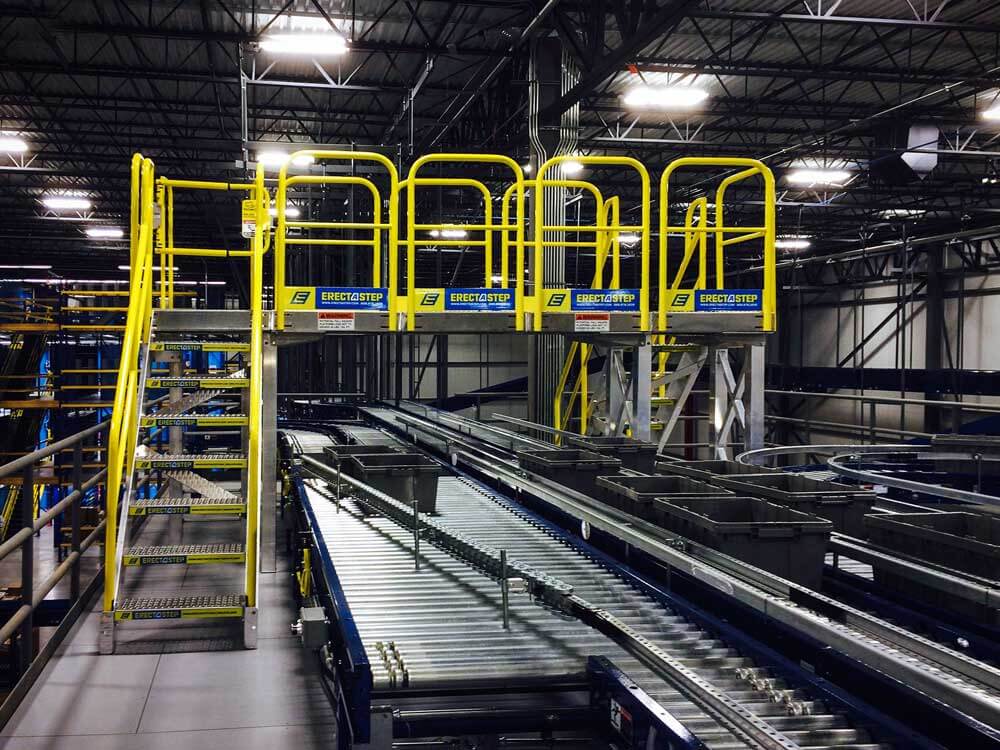Conveyor Systems Made More Efficient with ErectaStep Crossover Stairs & Platform
Categories: Industrial Stairs Food and Beverage Conveyor Crossovers & Access Crossover Stairs

Food supplier conveyor belt Crossover with platform
The conveyor belt has become essential in modern manufacturing and other industries. First invented in 1892 by Thomas Robins, he was one of the first people believed to be able to use a conveyor belt to move coal and ore. He was working for Edison Ore-Milling at the time. Robins pioneered conveyor belts, and his work revolutionized how industries moved coal, ore, and other products. His bosses at Edison Ore-Milling were very impressed with his work, and he even received the grand prize at the Paris Exposition in 1900 for his invention.
Conveyor belts are one of the most important inventions of the industrial revolution. Steel conveyor belts were then developed in 1901 by Swedish engineering company Sandvik, and they quickly became an essential part of factories and assembly lines worldwide. Due to their ability to quickly and efficiently move materials from one point to another, conveyor belts helped increase production rates and lower costs. One of the most famous users of conveyor belts was automobile pioneer Henry Ford. He utilized them in his Highland Park, Michigan factory to speed up Model T production, where they produced 15 million Model Ts from 1913 to 1927.
Today, conveyor belts are used in a wide variety of applications, from food processing to automotive assembly, to airport baggage handling or other logistics operations. Conveyor belts have many advantages over other methods of moving materials, including high speed and low cost. They are also relatively safe and reliable, making them essential equipment in many industrial settings.
Conveyor systems are essential in many workplaces but can also be dangerous. Employees can be injured if caught in the conveyor belt or if a moving object strikes them. In addition, conveyor systems can generate a lot of noise, damaging employees' hearing over time. To protect workers, manufacturing facilities must have well-designed conveyor systems and provide employees with training on working around them safely. In addition, it is important to have effective safeguards in place to prevent injuries and accidents. By taking these precautions, businesses can help create a safe workplace for all employees.
A food manufacturer in Australia needed crossover stairs over their conveyor system to provide a designated passageway for personnel. Work platforms and stairs are an important part of any workplace with impediments and hazards like conveyor systems, as they allow personnel to travel and navigate factory tasks without difficulty efficiently. In this case, the crossover stairs were necessary to enable the personnel to cross over lengthy conveyor belts efficiently. For workers in factories or warehouses, the crossover stairs provide a much-needed respite from the bottlenecks of conveyor belts and machine controls. Rather than walking around the entire system, these metal stairs allow quick access and workers to easily change direction, giving a break from the never-ending flow of packages. In addition, the crossover stairs can also be used as an 'emergency exit,' providing quicker paths to get away from bulky machines in case of mishaps. As a result, the crossover stairs are an essential part of any conveyor system, and their absence can create a tedious and dangerous work environment.
The manufacturer chose Erectastep work platforms because they are durable, easy to install, modular, and offer a high level of safety for users. Crossover stairs are a crucial part of any workplace with potential hazards, and they can make all the difference in ensuring a safe and efficient work environment. In any workplace, safety is of the utmost importance. This is especially true in food manufacturing, where employees constantly work with conveyor systems, hot ovens, and heavy machinery. A single slip-up can result in a serious injury, so food manufacturers must take every possible precaution to protect their workers. One of the most effective ways to promote workplace safety is to create a culture of safety within the organization, which means that safety should be everyone's responsibility from the top down. Employees should feel comfortable reporting safety concerns, and managers should proactively address them.





